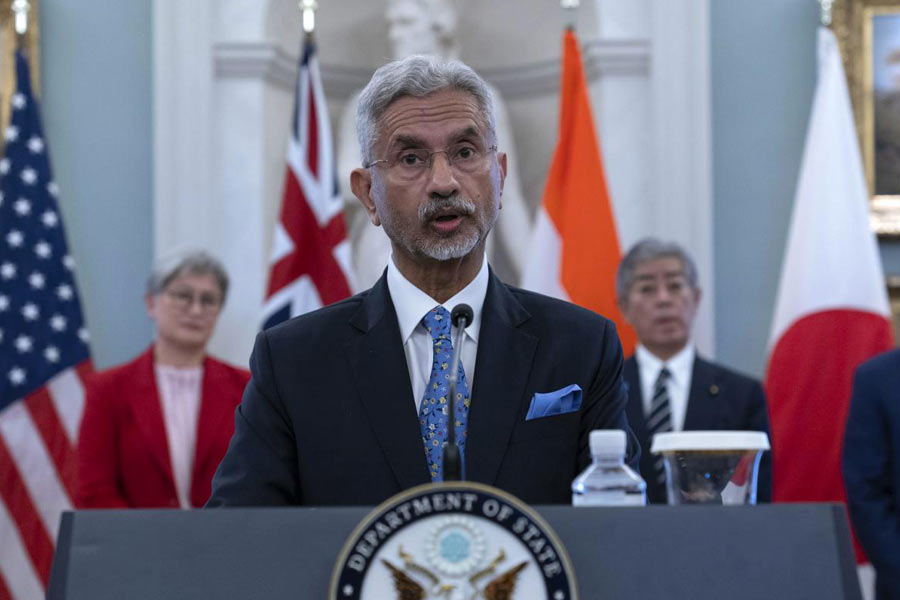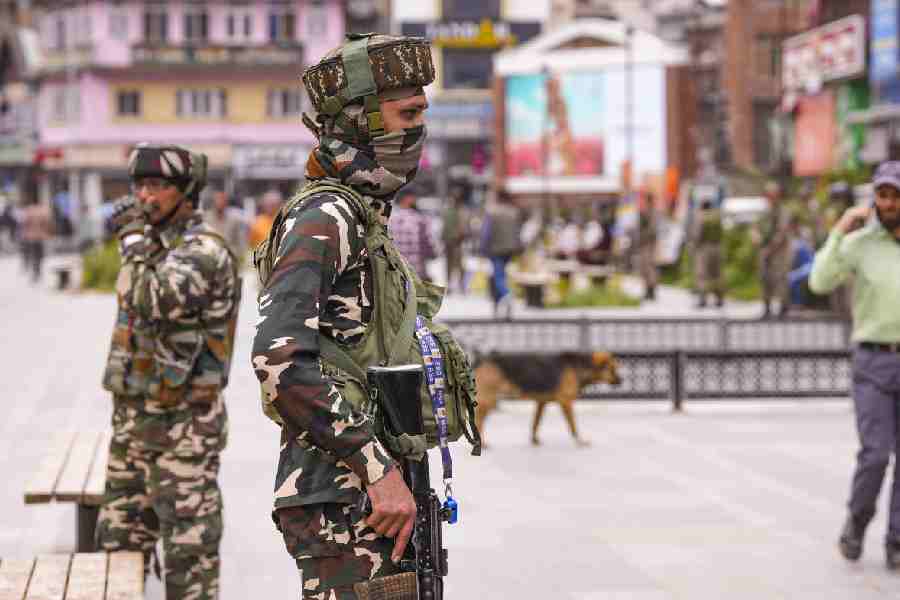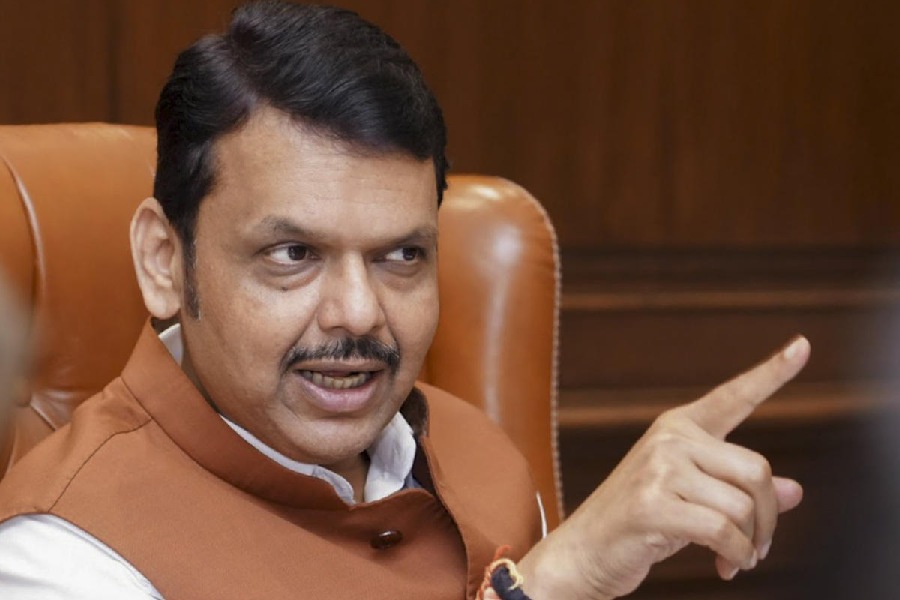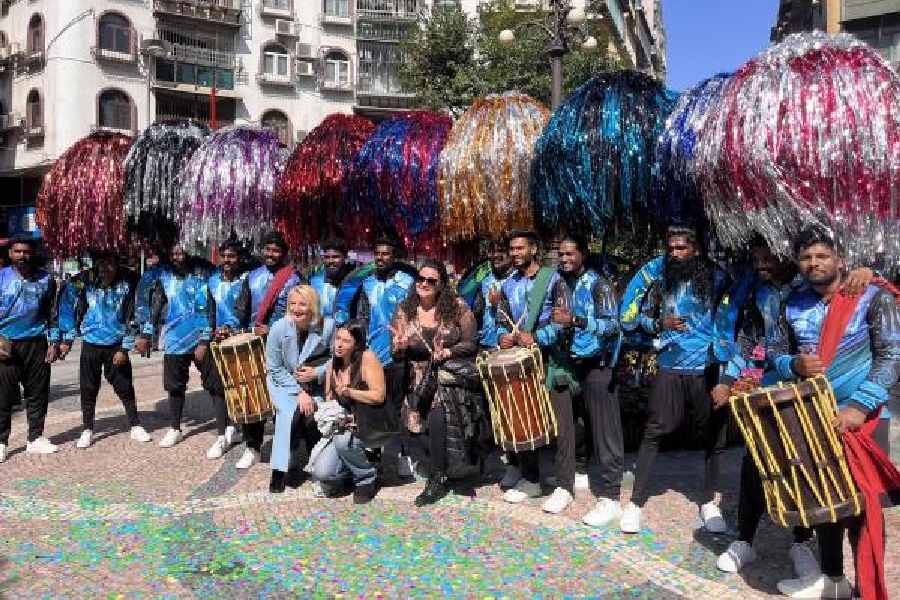STUDENTS DEBATE POLITICAL SYSTEM
Polls in India or soap opera
 |
| American Center deputy director Moulik D. Berkana hands over the winner’s trophy to the Birla High School (Boys) team. Picture by Anindya Shankar Ray |
American Center deputy director Moulik D. Berkana hands over the winner’s trophy to the Birla High School (Boys) team. Picture by Anindya Shankar Ray
The east zone finals of the LN Birla debate on July 11 saw arguments bandied back and forth at the Vidya Mandir auditorium on the topic, ‘Elections in India are a periodic entertainment package’.
Eight teams, shortlisted from 14 the day before through a preliminary round, fought it out before the judges for a place in the national finals, to be held in November in Calcutta.
The finals for the other three zones were held at Delhi, Bangalore and Pune.
The team of judges included Amrita Dhara, the head of languages at Max Mueller Bhavan and Moulik D. Berkana, the deputy director of the American Center.
Each team included two speakers, one speaking for and one against the motion.
Speaking for the motion, Radhika Chopra from Loreto House said: “As a 16-year-old, my only interest in politics is the entertainment it provides. BJP leader Narendra Modi can call Rahul Gandhi an aquarium fish and the Congress responds by calling him a piranha. Elections in India are nothing short of a soap opera.”
Agreed Srikanth Suresh of Hill Top School, Jamshedpur: “The functioning of the political brigade in our country is akin to that of the underworld. In fact, the latter seems more organised.”
Amongst the voices against the motion was Sunayan Mullik from Birla High School (Boys) who, quoting playwright George Bernard Shaw, said that people are governed no better than they deserve. “Casting our vote is not something we do for entertainment. In doing so, we take the future of the country in our hands for the next five years,” he added.
Nihita Agarwal of Birla High School (Girls) agreed. “That democracy continues to flourish in India is proof that elections continue to be important for the people,” she said.
An audience poll conducted on the spot indicated that the majority retained their faith in the electoral system.
The award for the best speaker went to Sunayan Mullik, who along with Arpit Banerjee, bagged the award for the best team. Sreevardhan Agarwal of La Martiniere for Boys was the first runner-up.
Sriyanta Chatterjee
 |
| A soiree organised in the city for the visiting teachers from the US last week. Picture by Bishwarup Dutta |
City of culture, but too noisy
They came, they saw and went back with an image of Calcutta different from what they thought it would be like.
Sixteen primary and secondary schoolteachers from across the US visited the city over the weekend to understand its culture better.
The visit to Calcutta was part of the annual Fulbright-Hays Summer Seminars Abroad 2009 organised by the American Center with the aim of exposing schoolteachers to Indian culture.
“All the teachers who are part of the programme teach Indian history, geography, art or music in the US,” said Sunrit Mullick, the regional officer and educational adviser at the United States India Education Foundation.
For the participants, the three weeks they spent in India were a revelation, they said.
“India is such a colourful country. There are so many kinds of people and cultures living together,” said Jane Denise Hundler, a teacher from Boston, Massachusetts.
The team visited various religious, cultural and educational institutions in and around Calcutta.
Over three days, the teachers met academicians to learn about eastern India, witnessed contemporary Indian dance and visited Victoria Memorial, St Paul’s Cathedral, BBD Bag, and the riverside.
“What I enjoyed most was the Bengal scroll folk paintings,” said Patricia Bartel, an art teacher from Indiana.
They also took a tram ride to south Calcutta from Esplanade, via Wellington, Nonapukur, Park Circus and Gariahat.
The teachers also undertook a culture tour and visited the Laxminarayan Mandir, St Aloysius’ Church and a madarsa in Uluberia.
“The image of Calcutta that they had was very different from what they experienced. They thought it would be overcrowded, poverty-stricken and chaotic. But they discovered order in the chaos,” said Mullick, the coordinator of the visit.
But one of the things that stood out was the level of noise pollution in the city. “The cars are honking all the time and so loudly. It is so disconcerting,” said Hundler.
The team has already visited Chennai, Delhi, Pune and Cochi and will be going to Varanasi, Agra and Jaipur before heading home.
“Each participant is working on a project on some aspect of India, which they will submit to the US state department and implement it in their respective schools,” said Mullick.
A STAFF REPORTER
 |
| A student sits at a classroom computer: Online boon or bane? |
Tech tools in classroom
St Xavier’s College held a two-day seminar on the impact of information communication and technology on teaching on July 9 and 10. It saw experienced names from academia discussing the objectives and hindrances of using technology in the present-day classroom.
“Our objective is to sensitise teachers about integrating technology into their teaching methods,” said Someswar Bhowmik, the director of Educational Multimedia Research Centre, Calcutta, the organisers of the seminar. Funded by the University Grants Commission, there are 17 such media centres in the country today.
At the inaugural session, Tilak Raj Kem, the director of the Consortium for Educational Communication (CEC) that coordinates the work of these centres, spoke about the need for online courses and lectures. “With the increasing demand for higher education, online courses and lectures will have to supplement the traditional college system,” he said.
Ashok Ranjan Thakur, the vice-chancellor of West Bengal State University in Barasat, spoke of the ways the problem of power shortage could be overcome for providing computer-aided education in remote villages. “Today, there are computers that need only 12 volts to operate. This power can be provided by solar panels,” said Thakur. He felt that this makes classroom learning interesting as it becomes peer-to-peer learning, taking away the tedium of teacher-centric classrooms.
Most speakers, though, were sceptical about the usefulness of technology in a country like India, where many schools fail to provide basic drinking water and sanitation facilities.
Most agreed with Kem that “technology is no replacement for conventional methods of teaching, but only a supplement to it.”
The initiative to spread education to remote areas using technology was adopted in 1984 when the Countrywide Classroom programme was started by CEC.
The aim was to spread education to students living in small towns and remote villages. These centres produce educational programmes that are telecast on television, as well as sold on CDs and DVDs.
Subhajoy Roy
Back to school, in Bangkok
School principals from the city are heading for Bangkok, all for the cause of education.
A city-based tour operator, Jet Setters, has invited the heads of 200 reputable schools from eastern and northeast India for a trip to the Thai capital for Principal’s Forum, a three-day event (September 3 to 6) with “Evolution in Education” as the theme.
“Teachers say the old system of education gave students a better foundation. Now kids browse the Internet and complete their assignments,” said Tarakeshwar Singh of Jet Setters. “The meet is a platform to assess the changes education is undergoing.”
The trip seems like a good image-building exercise for the tour operator too, given that even school excursions are headed abroad these days. Last year, Jet Setters had taken 35 principals to Goa.
Some students will also attend the Bangkok “bash”. There will be discussions, presentations, quizzes and debates. At a session titled “Back to School”, students will set up a class for the principals to tell them how they want to be taught.
“The schools will nominate their best students for this session and we will make the final choice,” said Singh.
Jet Setters has tied up with Thailand Tourism, which will sponsor some events.
“I am keen on participating as it will give us an opportunity to interact with others of the fraternity,” said Sunirmal Chakravarthy, the principal of La Martiniere for Boys.
Terence Ireland, the principal of St James, said: “I think this is the first time so many principals will be meeting abroad. It sounds exciting.”
Poulomi Banerjee
 |
| A student sits at a classroom computer: Online boon or bane? |
What’s on your mind this week
SHOUT OUT LOUD - A queer case of modernity
Our country is still fighting for free sexual choice, though Delhi High Court has repealed Section 377 of the Indian Penal Code, which criminalises homosexuality as “against the order of nature”.
We embrace western culture and call ourselves enlightened. Yet, though we lay claim to modernity, we are unable to embrace anything that does not fall within the ambit of the familiar.
We conceive of sexuality in binary terms of ‘straight’ and ‘gay’. We categorise behavioural traits as male or female, and anyone who does not conform is considered deviant.
Perhaps such an attitude is born out of the fear that were alternative sexuality given a place in society, queer people would wear their sexuality on their sleeves.
While a film like My Brother... Nikhil managed to look beyond sexual orientation and portray the individuals’ dilemmas, spoofing the issue a la the Kantaben episode in Kal Ho Na Ho or the faux-gay couple in Dostana (picture above) helps little in increasing awareness.
It is time we learned to respect the individuality of every human being. There is more to life than stereotypes. True awareness can only be achieved when we discard voyeurism and respect privacy.
Swagata Basu,Calcutta University










